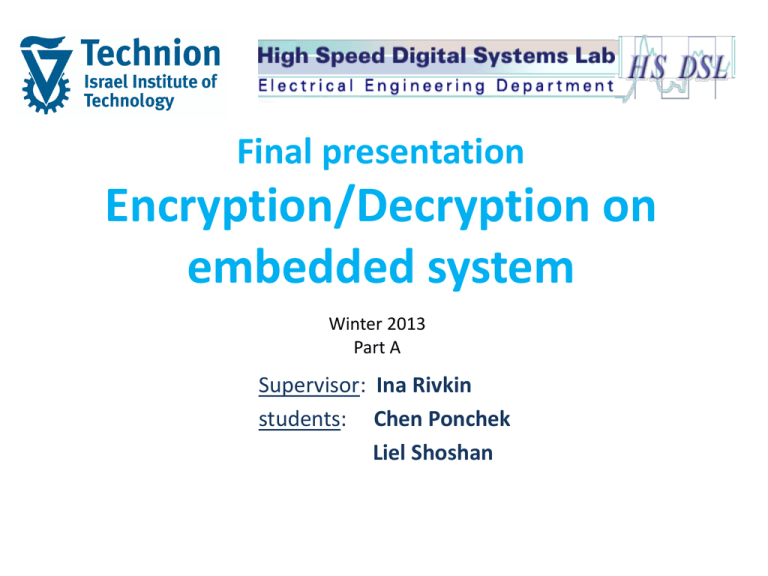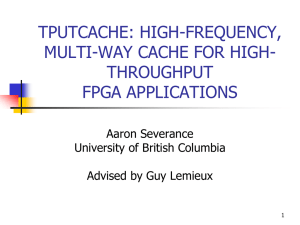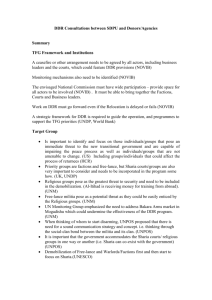Final presentation Encryption/Decryption on embedded system
advertisement

Final presentation Encryption/Decryption on embedded system Winter 2013 Part A Supervisor: Ina Rivkin students: Chen Ponchek Liel Shoshan motivation • Now days, there are many portable storage systems with large memories which contains valuable data (such as disk on key, tablets, etc.) • Therefore there is a concrete need for portable cryptography systems which are suitable for such devices. • In our project, we will aspire to provide a suitable system which will answer this need. Project Goal main goal: Implementation of data cryptography embedded system using AES algorithm and finding the suitable architecture for portable system. Project Specifications • Implementing on a Zync SoPC by Xilinx. • Suitable for portable systems (Disk-on-Key, tablets, etc.) - low power system. • Transparent system (while storing/loading files) - The cryptography system won’t create traffic bottle necks. • Finding the best architecture – according to the requirements above: • Profiling AES algorithm. • Finding the balance between using the ARM processor and using the FPGA (the hardware accelerator needs more power). AES algorithm • Advanced Encryption Standard, also known as “Rijndael”, is a block cipher. • The cipher is iterative, quick and comfortable to implement both by software and hardware, and it doesn’t have high memory requirements. • Most of the AES calculations are made through 10 rounds. • In each state the data block is described as a 2D, 4X4 array of bytes. • In each round a “Round Key” is created by the key-expansion process. • Each round consists of 4 steps: 1. SubBytes 2. ShiftRows 3. MixColumns 4. AddRoundKey System Block diagram Decrypted data DDR Encrypted data Zynq PS RS232 UART PL BRAM ZEDBOARD Zedboard Block Diagram System Block Diagram project part A Decrypted data Zynq DDR Encrypted data PS PL AES in software RS232 BRAM UART ZEDBOARD Implementation of AES algorithm on ARM and code optimization. Software Engineering • Each step is implemented as a separate function. • Each function is independent of the other functions. • The program can encrypt and decrypt the data. Software Engineering • The input data will be entered by the user via PuTTY terminal. • The program’s output is the data after encryption and the encrypted data after decryption. Encryption Process Development stages XPS/EDKConfiguring the ARM system: Creation of the ARM processor interface to the RS-232 UART. Addition of the Bram and Bram Controller IP and connection to the AXI Interconnect. Development stages PlanAhead Creation of the Top level entity in VHDL code. Generation of the Bitstream. Exporting hardware to SDK. Development stages SDK Generating the software platform project: • Creating Board Support package (BSP). • Selection of memory – DDR vs. Bram. Test in Hardware: • Downloading the application to the ARM processor. • Running and profiling the application. Profiling Bram vs. DDR Encryption and decryption of 10x16 Bytes 111.54 ms 2.754 ms Software optimization #1 • The MixColumns and InvMixColumns functions takes around 65%-70% of the whole process execution time. • Improving them will significantly reduce the delay time. Software optimization #1 • We will implement the MixColumns function using LUTs instead of arithmetic commands and if/else statements. • Should speed up the calculations. MixColumns initial implementation MixColumns improved implementation Bram With an Profiling improved 88.06 ms vs. MixColumns DDR implementation 2.626 ms Software optimization #1 Bram : • The total execution time decreased from 111.5 msec to 88 msec. • Decreasing in 21%. DDR : • The total execution time decreased from 2.754 msec to 2.626 msec. • Decreasing in 5%. Software optimization #2 • We will implement the MixColumns and the InvMixColumns functions using LUTs and without using for loops. • Should speed up even more the calculations. MixColumns optimized implementation InvMixColumns optimized implementation Bram With an Profiling improved vs. MixColumns DDR implementation With an optimized MixColumns and MixColumns implementation 47.427 ms 1.145 ms Software optimization #2 Bram : • The total execution time decreased from 111.5 msec to 47.427 msec. • Decreasing in 57%. DDR : • The total execution time decreased from 2.754 msec to 1.145 msec. • Decreasing in 58%. Hardware optimization The ARM processor clock: • At first, we used the default clock rate, which was 160MHz. • We will now set the clock rate to 225MHz (the maximum clock rate). Bram Profiling vs. DDR With higher clock rate ( 160MHz 225MHz) 34.798 ms 0.819 ms Hardware optimization Bram : • The total execution time decreased from 111.5 msec to 34.8 msec. • Decreasing in 69%. DDR : • The total execution time decreased from 2.754 msec to 0.82 msec. • Decreasing in 70%. Optimizations E x e c u t i o n ’s t i m e i m p r o v e m e n t 120 100 3 2.754 2.626 111.54 2.5 88.06 80 2 BRAM msec DDR 60 1.5 1.145 47.427 40 0.819 1 34.798 20 0.5 0 0 basic improved optimized higher clk rate Optimizations E x e c u t i o n ’s s p e e d i m p r o v e m e n t 5.00 250.00 4.60 4.50 4.00 200.00 3.37 3.50 195.36 KB/sec 3.00 150.00 139.74 2.50 BRAM 1.82 2.00 100.00 1.43 1.50 1.00 58.10 50.00 60.93 0.50 0.00 0.00 basic improved optimized higher clk rate DDR Execution’s speed improvement • Every optimization that we have made has decreased the total time and improved the speed. • The most significant improve was attributed by the 2nd SW optimization. • Both DDR and Bram speeds were eventually increased by 3 times and more. Bram vs. DDR • In every optimization : running the application from BRAM was significantly slower then running from DDR. • This is due to: – DDR has it own dedicated Bus. – The DDR clock rate is 550 MHZ, when BRAM clock rate is 160 MHZ. – DDR works on both rising and falling edge. Transmission rate • The typical maximum data rate in USB is 1.5 MB/s (The typical rates are around 0.5 MB/s.) • The encryption rate we were able to achieve at the end is 323 KB/s 1.5 times slower. • Conclusion: An hardware accelerator is needed. Project Specifications • Implementing on a Zync SoPC by Xilinx. • Suitable for portable systems (Disk-on-Key, tablets, etc.) - low power system. • Finding the best architecture – according to the requirements above: Profiling AES algorithm. Demonstration











